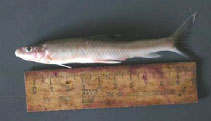| Diagnosis: |
Dorsal spines (total): 0-0; Dorsal soft rays (total): 10-10; Anal spines: 0-0; Anal soft rays: 8-8. Diagnosis: Garra tana is distinguished from African congeners by the following combination of features: very weakly developed disc; between 3 and 5 predorsal scales anterior to dorsal fin; chest, belly, and postpelvic region asquamate; elongate, narrow caudal peduncle, its length 20.4-22.3% of standard length, its depth 7.2-10.0% of standard length; and short intestine (Ref. 58532).
Description: Garra tana is slender and gracile, greatest body depth located well anterior to dorsal-fin origin, at level of pectoral-fin tip (Ref. 58532). Caudal peduncle elongate and narrow (Ref. 58532). Head short; snout prominent, with no tubercles, mouth wide; eyes positioned medially on head, and relatively large (Ref. 58532). Dorsal head profile rises steeply over snout, then more-or-less smoothly convex to dorsal-fin origin (Ref. 58532). Disc very weakly developed and inconspicuous without free posterior margin; rostral cap well-developed, ventrally expanded covering upper jaw and with clearly invecked ventral margin (Ref. 58532). Two pairs of small barbels; rostral pair frequently conspicuous and often longest (Ref. 58532). Either 39 or 40 scales along lateral line; between 3 and 5 predorsal scales anterior to dorsal fin; either 3 or 4 scales from lateral line to origin of pelvic fin; 4-4.5 scales from lateral line to dorsal-fin origin; chest, belly and postpelvic regions asquamate (Ref. 58532). Dorsal fin with iii,7 rays, inserted well anterior to pelvic fin, with subacuminate, third branched ray longest; anal fin with iii,5 rays, with subacuminate tip; pectoral fin with iv,11 rays, its length 16.6-20.2% of standard length, with somewhat pointed tips (Ref. 58532). Predorsal length 39.8-50.0% of standard length (Ref. 58532). Vent located distant from anal fin (Ref. 58532).
Colouration: Body dark dorsally, lighter brown below lateral line and ventrally (Ref. 58532). Head, snout and most of cheek and opercle dark brown; lips, gular region, posterior opercle and branchiostegal membranes pale yellow-brown (Ref. 58532). Dorsal fin membrane with pale cream tip, faint submarginal band of black pigment in membrane between rays, and pale cream proximally; some specimens with faint trace of either 5 or 6 very small black spots between rays in basal membrane of dorsal fin, but in most specimens dorsal-fin spots absent; anal fin uniformly pale creamy yellow; caudal fin pale creamy brown, with median rays a contrasting darker brown; pelvic and pectoral fins uniformly pale creamy brown (Ref. 58532). |

